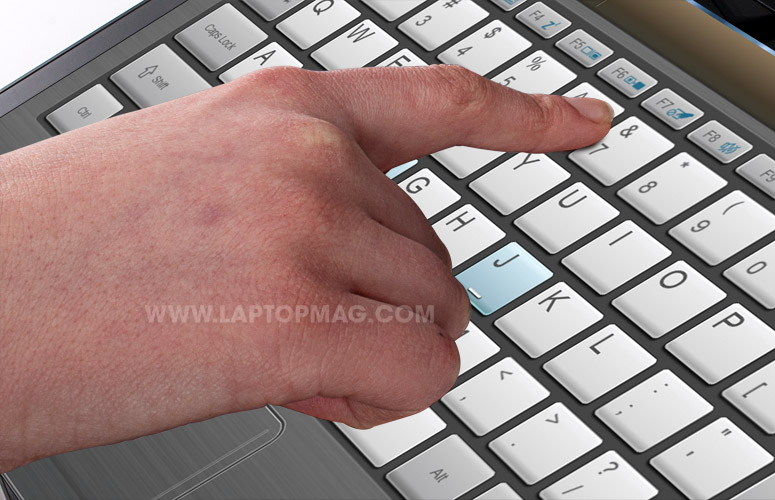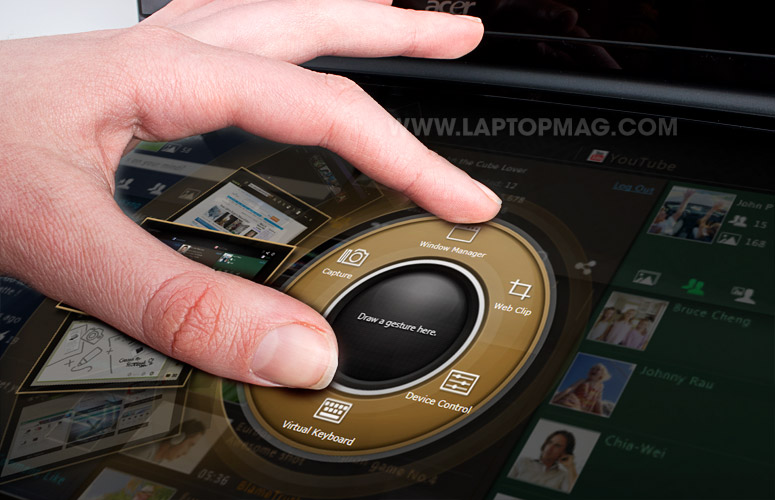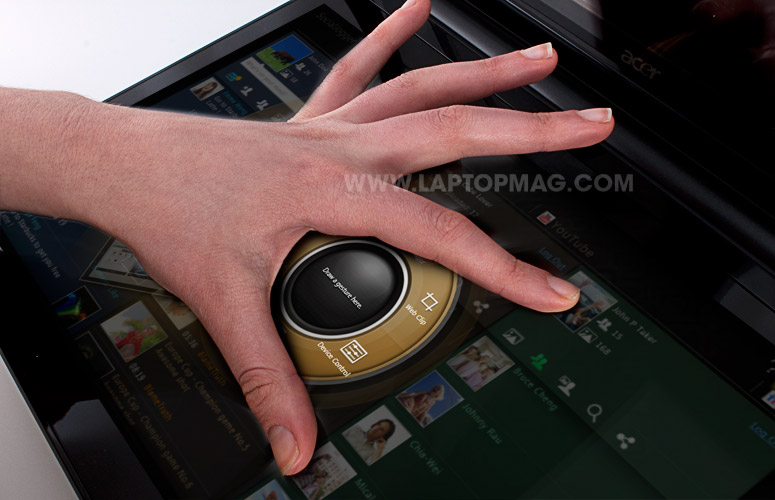Laptop Mag Verdict
Sporting dual 14-inch touchscreens and innovative software, the Acer Iconia 6120 makes Windows more touch-friendly, but its bulk and short battery life are turn-offs.
Pros
- +
Innovative touch software
- +
Easy-to-use virtual keyboard
- +
Strong overall performance
- +
Quality webcam
Cons
- -
Short battery life
- -
Touch apps slow to load
- -
No SD Card slot
- -
Heavy
Why you can trust Laptop Mag
The Acer Iconia 6120 isn't the first dual-screen Windows 7 tablet on the block. The Toshiba Libretto W105 had two 7-inch displays and was about the size and weight of a paperback, but its short battery life and lackluster software doomed that device to collectible status. The Iconia is different. It's more like a coffee table book, a book that features two large 14-inch displays and innovative touch-enabled software, plus a Core i5 processor. But does this $1,199 tablet-book represent the future of laptops, or is it just a pricey experiment destined to appeal only to early adopters?
Design
The Acer Iconia 6120 has a fairly sophisticated look. The lid and bottom are both a champagne-colored metal. The bottom, one solid panel, has two rows of small square cutouts for ventilation and speakers, and can be removed easily with two sliding latches. There are only two physical buttons on the Iconia: The right hinge has a power button, and the left hinge activates the virtual keyboard. The Iconia's two touchscreens are each 14 inches, surrounded by a glossy black bezel.
While the Iconia's dimensions--13.5 x 9.7 x 1.2 inches--are typical for a 14-inch system, the notebook is on the heavy side: 6 pounds. We definitely noticed it carrying it home in a messenger bag. That's the price you pay for two displays.
Keyboard
For a virtual keyboard, the Acer Iconia's was fairly easy to type on, though not perfect. Aside from using the physical button on the left hinge to turn on the keyboard, we could also activate it by pressing our palms down simultaneously on the lower display; a neat shortcut.
The keyboard extends almost the entire width of the screen, and the Iconia 6120 presents the keys in a chiclet-style layout. On the upper right is a set of shortcuts that can be switched between media controls and editing tools (i.e., save, cut, paste, and print). When you press a key, the Iconia 6120 makes a click, not unlike a typewriter. You can adjust the volume or turn off the sound completely in the settings, as well as set skins and even calibrate the key pitch to best suit your typing. The keyboard also comes with a predictive text option (XT9), but we found that it was easier to type without this feature activated.

Click to enlarge
While we weren't able to type as fast on the Iconia 6120 as with a real keyboard, we did manage a fairly quick rate after about half an hour of practice, so much so that a fair amount of this review was written using the virtual keyboard. We had to be much more careful with what we did with our non-typing fingers, though. Any errant grazing of the screen, and we'd end up with a wrong letter. Overall, we made many more mistakes compared to a traditional keyboard, but it worked.
Click to enlarge
An icon in the upper left also lets you switch to a notepad, where you can add text by writing with your finger. We found this method to be much less accurate. When we scrawled "The Quick Brown Fox," for example, it ended up as "The quick brunet."
The virtual touchpad was a smallish 2.5 x 2.1 inches, but we were able to use it as easily as a real touchpad. There are two virtual mouse buttons below, but considering the whole thing is a touchscreen, why not just make it a virtual clickpad, à la an Apple MacBook?
Display and Audio
The dual 14-inch (1366 x 768) displays on the Iconia 6120 are made out of the more durable Gorilla Glass. The fingerprint-resistant coating helped somewhat, but you'll want to keep a cloth handy. Both screens have a glossy finish, but that only proved to be an issue with the upper display, as its vertical orientation reflected more lights. Colors were somewhat muted; while watching the trailer for Captain America, the red, white, and blue of the uniform didn't really pop. Horizontal viewing angles were good enough so that three people would be able to comfortably see the screen, but vertical viewing angles were quite narrow. Normally, this wouldn't be a problem, but when you consider that the display can tilt back 180 degrees to lie flat on a table, it becomes an issue.
Click to enlarge
Both capacitive touchscreens were very responsive, interpreting our finger gestures accurately. Interestingly, given all that we could do with the lower touchscreen, we didn't find ourselves using the upper touchscreen much at all.
Speakers located on the underside of the Iconia 6120 pumped out a fair amount of volume, and there was a respectable amount of bass. However, the mid and high range were very muddy.
Ports and Webcam
On the left side of the Iconia 6120 are two USB 2.0 ports, as well as HDMI. On the right is a USB 3.0 port, Ethernet, VGA, headphone and mic (which doubles as an S/PDIF port), and a Kensington lock slot. Sadly, there's no SD card slot. (Seriously.)

Click to enlarge

Click to enlarge
The Iconia's 1.3-megapixel webcam was excellent; capable of capturing video at resolutions up to 1280 x 1024, it accurately recorded our skin tones, and even picked up the flecks of brown in our hazel eyes.
Heat
After playing a Hulu video for 15 minutes at full screen on the Iconia 6120, the area around the virtual touchpad measured 87 degrees Fahrenheit, the space between the G and H keys was 90 degrees, and the middle of the underside was 95 degrees. That last measurement is on the border of what we consider uncomfortable.
Acer Ring Software
As any tablet maker knows, it's the quality of the software that determines how useful a touch-enabled device will be. That's why we were heartened to see the effort that Acer put into its suite of software. However, like most first attempts, there were some hits and misses. Right off the bat, we found that it took a number of seconds to launch each app on the Iconia 6120; the spinning circle became a minor annoyance.
Pressing the tips of all five fingers on the lower screen activates the Acer Ring, providing access to four applications: TouchPhoto, TouchVideo, TouchMusic, SocialJogger, Touchbrowser, Scrapbook, and My Journal. Here, you can also access various settings, such as gesture controls (more on that later).

Click to enlarge
Of all the apps, SocialJogger is the one Iconia 6120 owners will likely use most; opening up in one display, three panes show your Facebook, YouTube, and Flickr feeds. It's neat to have at-a-glance access to your feeds. You can also set the news feed for favorite friends, and share photos and videos by dragging them into one of the panels. You can also set how often the feeds update, but we wish SocialJogger supported services like Twitter and RSS feeds.
Click to enlarge
TouchBrowser opens up a web browser that extends across both displays, with navigation controls at the bottom of the lower screen. One of the icons lets you switch between extending the browser across both screens, or just the upper display. The tabbed interface is easy to navigate by touch, but having it extend across two screens doesn't make browsing necessarily better because the display bezels are so thick. Another icon here let us select a portion (or all) of a web page and then copy it to the Scrapbook or My Journal for later viewing. We wish Acer would add a touch-to-share option here for e-mail and social networks.
Click to enlarge
My Journal acts sort of like a graphical bookmark: If you create a web clip, you can paste it to My Journal, and place it in one of five tabs along the top: Technology, Sports, Entertainment, Politics, and Business, and resize the clip to fit more on a page. In a clever twist, clicking on a link in one of the clips opens it up in a web browser on the upper screen. However, the content on the web clip you saved doesn't remain static--it refreshes just like the actual web page--so it's not a record of a moment in time.
TouchVideo, TouchPhoto, and TouchMusic are all fairly straightforward, each providing a touch-friendly interface for accessing those respective types of media. Scrapbook lets you import photos and web clips, and draw overtop them, much like Toshiba's Bulletin Board app; it's fun, but not necessarily all that useful.
Click to enlarge
The Gesture Editor lets you create your own gestures to launch programs, URLs, or search. While it was easy to create custom gestures to, say launch Skype, executing them was less intuitive. Somewhat confusingly, you have to initiate the gesture from the middle of the Acer Ring, but in order for the notebook to recognize it, the gesture must extend outside the ring, which isn't immediately obvious.
Unlike HP's TouchSmart software for its all-in-one PCs, you won't find an app store on the Iconia 6120. HP also includes apps for Hulu, Facebook, and Twitter. With Acer's dual-screen notebook, there just aren't any third-party options--at least not any that are easy to find.
Performance
The Acer Iconia 6120 comes with a 2.66-GHz Intel Core i5-480M processor, 4GB of RAM, and a 640GB, 5,400-rpm hard drive. On PCMark Vantage, which measures overall system performance, the Iconia scored 5,848, which is about 700 points above the mainstream category average, and 300 points better than the ASUS U41Jf-A1. The Iconia 6120 was also fairly speedy when transcoding video: Converting a 114MB MPEG4 to AVI using Oxelon Media Encoder took 51 seconds (almost 30 seconds faster than average).
The 5,400-rpm hard drive duplicated a 4.97GB folder of multimedia in 3 minutes and 2 seconds, a rate of 28MBps, about 2 MBps faster than average. The Iconia 6120 booted into 64-bit Windows 7 Home Premium in a slow 1 minute and 27 seconds; that's to be expected with the amount of software it has to load, but it's still unfortunate.
While the integrated Intel HD graphics in the Iconia were strong enough to power two touch-enabled displays for watching movies streamed over the Internet, you're not going to be doing any heavy gaming on this system. The notebook scored 2,680 in 3DMark06, about 1,000 points below average. That low benchmark was reconfirmed in our World of Warcraft test: The Iconia mustered just 17 frames per second at the recommended settings, about half the category average.
Battery Life and Wi-Fi
As a notebook's display is the main power drain, it's no surprise that the two screens on the Iconia would result in poor endurance. Acer estimates battery life at just 3 hours, and we saw even less runtime during our testing. When we set both screens to 40 percent brightness and ran the LAPTOP Battery Test (web surfing via Wi-Fi), the Iconia lasted just 2 hours and 23 minutes. That's about 2 hours less than the mainstream notebook average, and even less than the desktop replacement average.
Thankfully, the Iconia's wireless scores were quite robust. At 15 feet from our router, we saw throughput of 41.8 Mbps, which dropped to 24.4 Mbps at 50 feet. The category averages are 34.7 and 22 Mbps at those respective distances.
Software and Warranty
Outside of the Acer Ring, Clear.fi software lets you browse all your multimedia in a single touch-friendly interface. Provided you have accounts for Facebook, Flickr, and YouTube, you can access photos and videos from, and upload content to, those sites. It's ease of use and integrated design makes TouchVideo, TouchPhoto, and TouchMusic almost redundant.
Other software pre-loaded on the Iconia includes Acer eRecovery Management, Nook, New York Times Reader, Norton Online Backup, Acer Crystal Eye webcam software, eSobi, MyWinLocker, Skype, and trials of Microsoft Office 2010 and McAfee Internet Security Suite.
Acer backs the Iconia 6120 with a One-year International travelers limited warrranty. Click here to see how Acer fared in our Tech Support Showdown. You can also see how the company fared in our Best & Worst Brands report here.
Click to enlarge
Verdict
We've slammed a lot of Windows-based consumer tablets for not taking the touch experience seriously, so Acer deserves some credit for innovating here. The Acer Ring interface on the Iconia 6120 is a cool way to interact with the notebook; the touch keyboard is workable; and SocialJogger represents a fresh way to access social network information in a single place. Still, this notebook is heavy and its battery life is short. And while the apps are interesting, they take a while to load and don't truly take advantage of the unique design. What this notebook is crying out for is software that can better take advantage of the two displays when laid flat, especially games. Overall, the Iconia 6120 is a fresh take on the Windows tablet, but we'd like to see a slimmer design and a wider selection of touch apps.

Click to enlarge
Acer Iconia 6120 Specs
| Brand | Acer |
| CPU | 2.66-GHz Intel Core i5-480M |
| Company Website | www.acer.com |
| Display Size | 14 |
| Graphics Card | Intel HD |
| Hard Drive Size | 640GB |
| Hard Drive Speed | 5,400rpm |
| Hard Drive Type | SATA Hard Drive |
| Native Resolution | 1366x768 |
| Operating System | MS Windows 7 Home Premium (64-bit) |
| Ports (excluding USB) | Microphone, Kensington Lock, Headphone, HDMI, Ethernet, VGA, USB 3.0 |
| RAM | 4GB |
| RAM Upgradable to | 8GB |
| Size | 13.5 x 9.7 x 1.2 inches |
| USB Ports | 3 |
| Video Memory | 128MB |
| Warranty/Support | One year international travelers limited warranty |
| Weight | 6 pounds |
| Wi-Fi | 802.11b/g/n |
Michael was the Reviews Editor at Laptop Mag. During his tenure at Laptop Mag, Michael reviewed some of the best laptops at the time, including notebooks from brands like Acer, Apple, Dell, Lenovo, and Asus. He wrote in-depth, hands-on guides about laptops that defined the world of tech, but he also stepped outside of the laptop world to talk about phones and wearables. He is now the U.S. Editor-in-Chief at our sister site Tom's Guide, where he oversees all evergreen content and the Homes, Smart Home, and Fitness/Wearables categories for the site..
